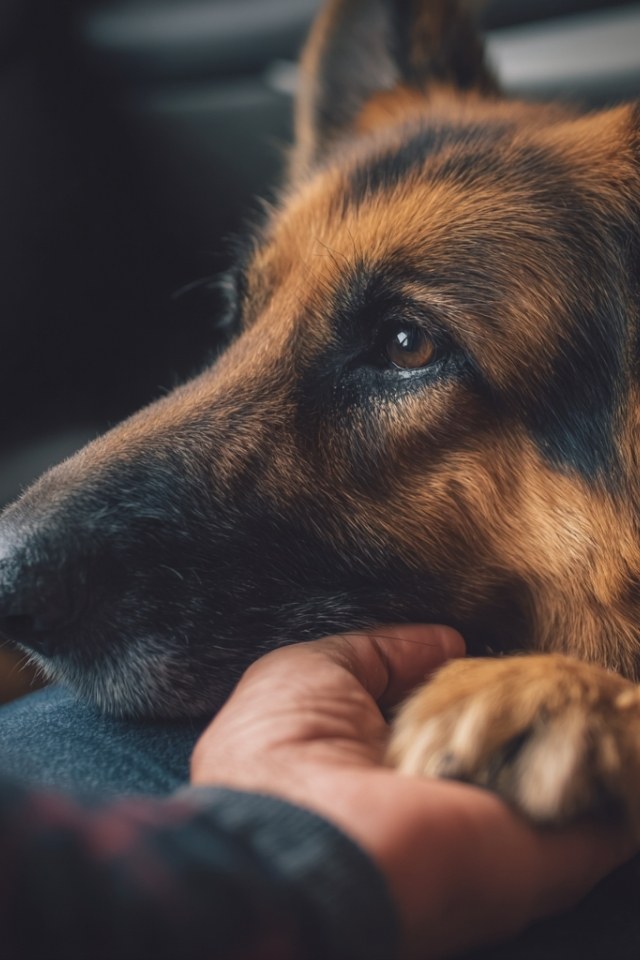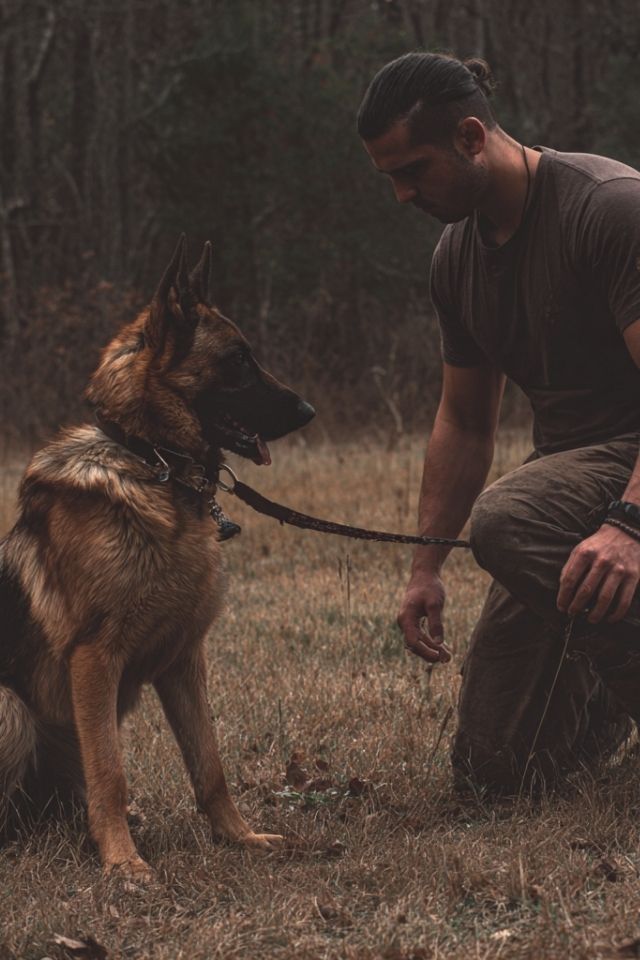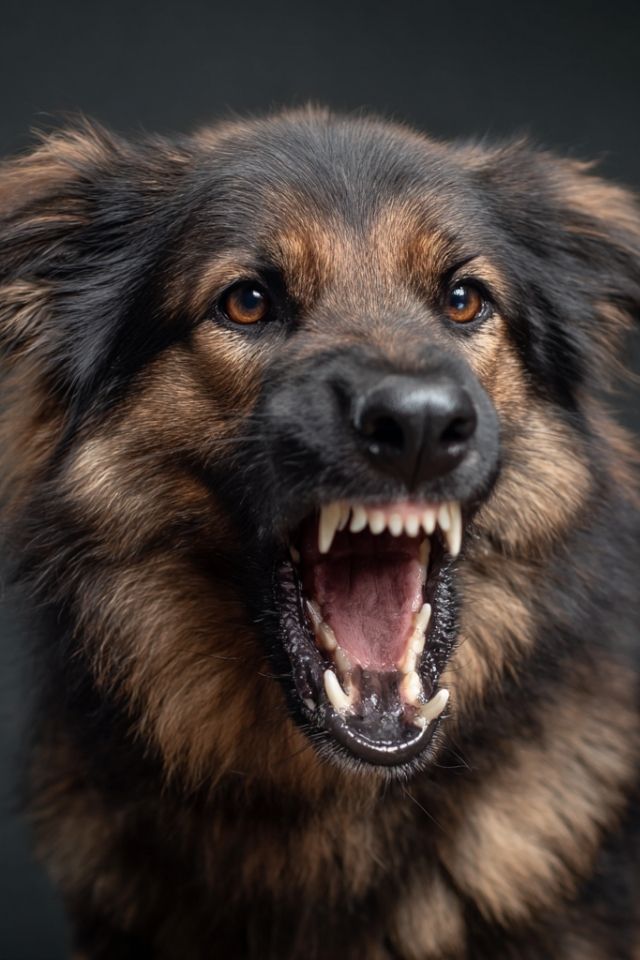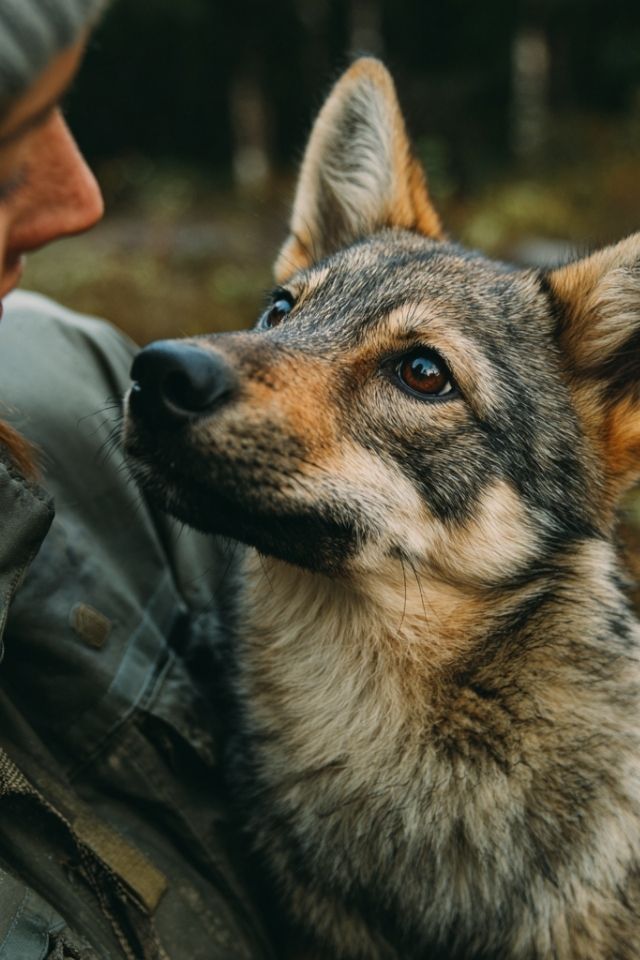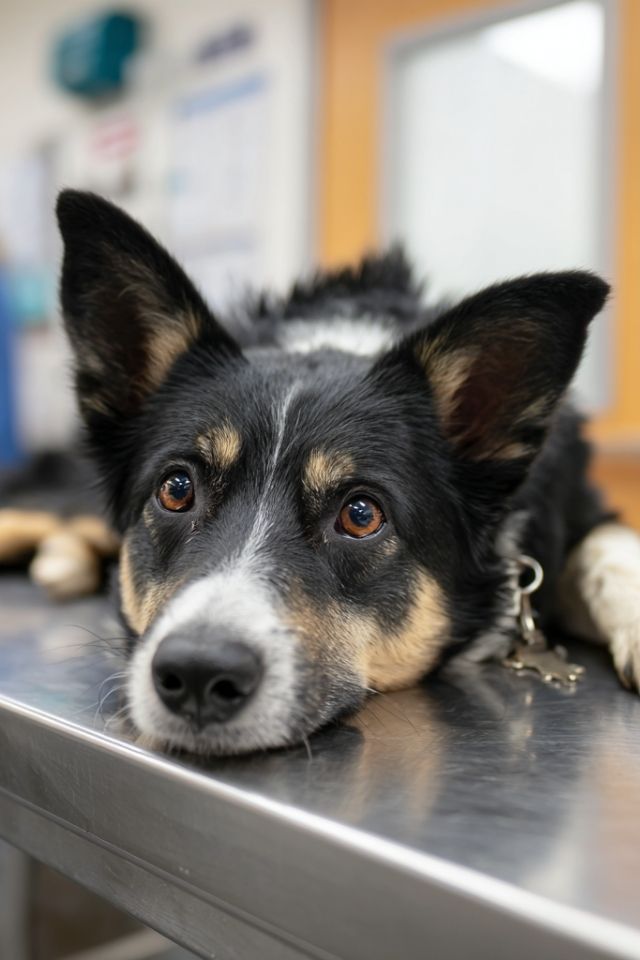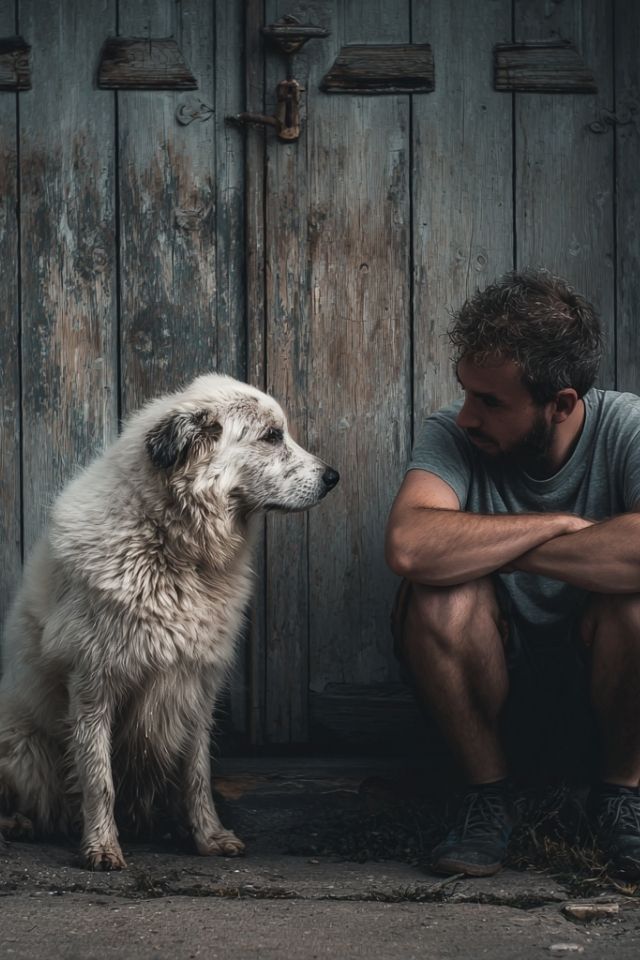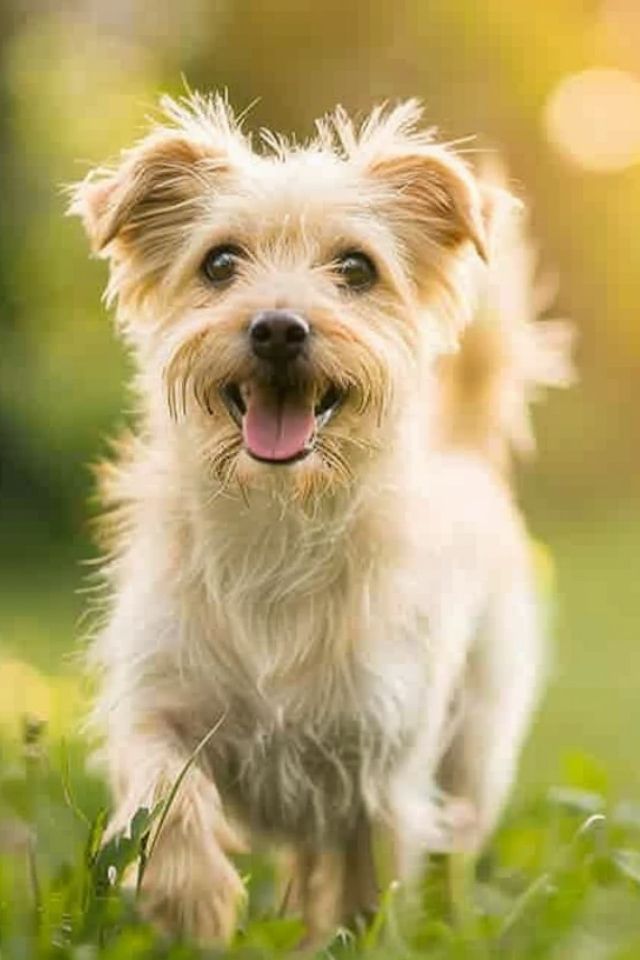A Moment at the Door
Picture this: the doorbell rings, and your dog’s entire body lights up with joy. Guests are coming—their favorite thing. They rush to the door, tail helicopter-spinning, every muscle vibrating with excitement. The door opens, and in their purest expression of welcome, they leap.
“No!” The word cuts through the air.
They drop. Pause. Leap again.
“No!” Louder this time, edged with frustration.
Your dog freezes mid-jump, eyes darting between you and the guests, tail lowering. Confusion ripples across their face. They want to do the right thing—you can see it in how they hold their body, tense and uncertain. But what is the right thing? The word “No” hangs in the air like smoke, offering no answer, no direction, no way forward.
This moment—this tiny fracture in understanding—happens in homes everywhere, dozens of times a day. And each time, something small but precious erodes: the clarity between you, the trust that you’ll guide them through the world, the joy of simply being together. 🧡
What Your Dog Hears When You Say “No”
Let me take you inside your dog’s experience for a moment. When you say “No,” their brain receives a signal—but it’s a signal without a map, a warning without coordinates.
Research into canine cognition reveals something beautiful and vulnerable: dogs approach our communication with profound optimism. They expect that when we speak to them, we’re offering something clear, something they can grasp and act upon. Their minds are wired to process cues that feel easy, informative, meaningful. When you point, they follow your finger. When you open your arms, they know welcome awaits. This is the language they understand—the language of direction, of invitation, of “here’s where we’re going together.”
But “No” offers none of this. It’s a wall without a doorway. Your dog knows something is wrong, but not what would be right. In that gap between wrong and right, anxiety blooms. Their amygdala—that ancient alarm bell deep in the brain—begins to ring. Not with understanding, but with threat assessment.
When Learning Becomes Survival
Here’s what happens in those moments: your dog’s heart rate climbs. Stress hormones course through their bloodstream. Their cognitive resources, which were ready for learning and connection, pivot sharply toward survival. The very architecture of their attention shifts from “What does my human want?” to “Am I safe?”
And here’s the remarkable, almost heartbreaking part: your dog can smell this shift in you too. When frustration tightens your jaw, when your voice carries that sharp edge of exasperation, your body releases stress markers that your dog’s extraordinary nose detects instantly. They smell your tension. They feel it in their own bodies through the invisible threads of emotional contagion that bind you together.
In this state—you stressed, them stressed—learning becomes nearly impossible. The window for understanding closes. What remains is confusion wrapped in anxiety, and a small, accumulating erosion of trust. 🧠
The Weight of Words Without Meaning
I once watched a young Border Collie named Maya during a training session. Brilliant dog—the kind whose eyes track your every movement, who seems to anticipate your thoughts. Her owner, a kind person genuinely trying their best, used “No” like punctuation. “No” when Maya sniffed too long. “No” when she moved toward another dog. “No” when she pulled on the leash.
After fifteen minutes, I watched something shift in Maya’s body language. Her ears, usually perked forward in eager attention, flattened. Her tail, typically high and expressive, lowered. Most telling of all: she stopped looking at her owner’s face. She stopped checking in, stopped seeking guidance. She had learned something, but not what her owner intended. She’d learned that trying didn’t work, that her best efforts led nowhere.
This is learned helplessness wearing a leash.
The Architecture of Giving Up
When your dog hears “No” repeatedly without ever learning the “Yes” that lives on the other side, something begins to collapse inside their understanding of the world. They’re being told they’re wrong but never shown how to be right. It’s like being lost in a maze where every turn triggers an alarm, but no path leads to freedom.
Psychologists have documented this phenomenon—the moment when an animal or person stops trying because nothing they do seems to matter. In dogs, it looks like shutdown: the averted gaze, the slow movements, the refusal to engage. People often mistake this for stubbornness or dominance. It’s neither. It’s a nervous system protecting itself the only way it knows how—by withdrawing.
Your dog isn’t defiant when they “ignore” your repeated “No.” They’re drowning in ambiguity, and they’ve stopped swimming. 💙
The Language Dogs Actually Speak
There’s a different way. A way that honors how your dog’s mind actually works, that builds bridges instead of walls.
Imagine that same moment at the door. The doorbell rings. Your dog’s joy ignites—but this time, before they reach full leap, you speak a word they know with crystalline clarity: “Place.”
They know this word. It has a shape in their mind, a clear action attached: go to your bed, settle there, and good things flow. They move to their spot. You mark the moment with warmth: “Yes!” A treat appears. Guests enter, and your dog stays—not because they’re suppressed or fearful, but because they know exactly what earns your approval.
This is teaching through clarity. This is the Invisible Leash made visible—guidance that flows through awareness and understanding rather than through tension and correction.
Replacement: The Gift of Direction
Every behavior your dog offers comes from somewhere. When they jump on guests, they’re seeking connection and attention. When they pull on the leash, they’re following their nose and exploring their world. When they bark at the window, they’re alerting you to changes in their territory. These aren’t character flaws. They’re expressions of perfectly natural drives.
The question isn’t how to stop these drives—it’s how to channel them into forms you both can live with.
When your dog jumps, teach them that sitting magnetically attracts attention. Four paws on the floor becomes the key that unlocks the very thing they want.
When your dog pulls, become a tree. Stop moving until the leash relaxes, then the world opens again. They learn through their own experience: tension stops the adventure, softness continues it.
When your dog barks, acknowledge their vigilance—”Thank you”—then redirect their energy: “Quiet” or call them to you. You’ve honored their instinct while shaping its expression.
In each case, you’re teaching what to do, not just what to stop. And in that teaching, your dog’s intelligence blooms. They become problem-solvers, choice-makers, partners in the dance of daily life. 🧡
The Space Between Stimulus and Response
There’s a moment—a breath—between when your dog does something you don’t want and when you respond. In that space lives your power to shape everything that follows.
I learned this from a German Shepherd named Atlas, or rather, from watching his person learn it. She came to me frustrated, defeated. “He doesn’t listen,” she said. “I say ‘No’ fifty times a day and nothing changes.”
We spent a session simply observing. Watching Atlas move through space. Noting what preceded the behaviors she wanted to stop. And crucially, watching her own body and breath when those behaviors occurred.
What she discovered changed everything: her “No” wasn’t instruction. It was discharge—an outlet for her own frustration and helplessness. And Atlas, sensitive creature that he was, absorbed that frustration like a sponge. His behavior wasn’t improving because he was learning her stress, not her guidance.
Your Calm Is Their Compass
When you learn to regulate your own nervous system—to pause, breathe, center yourself before responding—you become a different kind of teacher. Your dog feels this shift instantly. The air around you changes. Where there was tension, there’s now steadiness. Where there was frustration, there’s now curiosity.
This is where NeuroBond lives: in the space where your regulation becomes their regulation, where your clarity becomes their confidence.
Try this: The next time your dog does something that triggers your frustration, pause. Take three slow breaths, deep enough that your shoulders drop. Notice how your jaw unclenches. Feel your feet on the ground.
From this place—centered, present, clear—then respond. Not with “No,” but with direction. Name what you want. Guide them there. Mark their success.
Watch what happens. Watch how their body softens when yours does. Watch how they look to you with new attentiveness when you become a source of clear information instead of unpredictable tension. 🧠
The Story Your Dog Remembers
Moments of Soul Recall aren’t just poetic language—they’re neuroscience wrapped in metaphor. Every interaction you have with your dog writes a line in their emotional memory. These memories aren’t filed neatly by date or location. They’re filed by feeling.
When your dog’s strongest training memories involve confusion and correction, when their body remembers the tight feeling in their chest as you said “No” again and again, these emotional imprints become the backdrop for all future learning. They approach new lessons already braced for failure, already anticipating your disappointment.
But when their memories are built on clarity and success—on moments when they understood exactly what you wanted and earned your genuine delight—they approach learning with openness. With optimism. With the kind of engagement that makes training feel less like work and more like conversation.
Building Confidence Through Understanding
There’s a Golden Retriever I know named Luna whose entire demeanor transformed when her family shifted from correction to clarity. In the “before,” Luna would freeze when asked to do something new, her eyes showing whites, her body tense with anticipation of failure. She’d been “No’d” into uncertainty, taught that trying often led to disappointment.
In the “after,” Luna became a different dog—or rather, she became herself. Ears forward, tail loose, eyes bright with engagement. She began offering behaviors spontaneously, checking in: “Is this it? How about this?” Not from anxiety, but from curiosity. She’d learned that her attempts wouldn’t be met with correction but with information. That even if she didn’t get it right the first time, the path to success was findable, learnable, safe.
This is what we’re really building when we teach through clarity: not just obedience, but confidence. Not just compliance, but partnership. 💙
The Practice of Presence
Moving from correction to clarity isn’t a technique you master in a weekend. It’s a practice—a way of being with your dog that deepens over time.
This week, simply notice. Count how many times “No” or its cousins (Stop, Don’t, Quit it) leave your mouth. Don’t judge yourself for it. Just notice. Awareness is always the first step toward change.
Next, begin asking the question that changes everything: “What do I want instead?” Before “No” leaves your lips, pause. Identify the behavior you’d prefer. Then teach that, guide toward that, reward that.
Over time, watch what happens in the space between you. Watch how your dog begins to check in more frequently. How they seem more relaxed even during training. How mistakes become less fraught with emotion and more simply information: “Ah, not that—this.” How your relationship begins to feel less like a series of corrections and more like a conversation.
The Invisible Leash isn’t about never setting boundaries. It’s about setting them through guidance rather than through force. It’s about leading through clarity rather than through control. And in that shift—from “No” as a blunt instrument to teaching as a precise art—everything transforms. 🧡
Where Science Meets Soul
The research is unambiguous: dogs trained through positive reinforcement and clear direction learn faster, retain longer, and show more resilience when facing new challenges. Their cortisol levels stay balanced. Their oxytocin levels—that neurochemical signature of bonding and trust—rise during training rather than fall.
But beyond the data, beyond the brain scans and hormone measurements, there’s something else. Something you can’t quite quantify but can absolutely feel: the quality of connection that emerges when you and your dog understand each other.
It’s there in the way they look at you when they’re uncertain, seeking guidance rather than fearing judgment. It’s there in how eagerly they engage with training, moving toward you rather than away. It’s there in the softness in their eyes, the looseness in their body, the sense that you are, together, on the same team.
That balance between science and soul—between understanding the mechanics of learning and honoring the emotional reality of relationship—that’s the essence of Zoeta Dogsoul.
The Choice Before You
You stand now at a doorway. Behind you lies the familiar path of correction, of “No” as reflex, of training as something you do to your dog. Ahead lies something different: training as something you do with your dog. Communication as collaboration. Teaching as an art of clarity and patience.
The path ahead asks more of you. It requires that you become fluent in reading the subtle shifts in your dog’s body language. That you learn to regulate your own nervous system. That you think ahead, plan proactively, teach preventatively. That you celebrate progress over perfection and see mistakes as information rather than failure.
But what it offers in return is everything: a dog who trusts you completely, who learns with joy, who faces the world with confidence because they know you’ll guide them through it with clarity and kindness.
Your dog is ready. They’ve been ready. Waiting, actually, for you to speak a language they can finally understand.
The question isn’t whether they can learn. The question is: are you ready to teach in a way they can hear? 🧡
